|
On Wednesday 17th August a group of MCG members met Architect Ahmad Najib Affin (known to all as 'Nadge') - our guide for a walking tour of Kampung Baru (KB). |
|
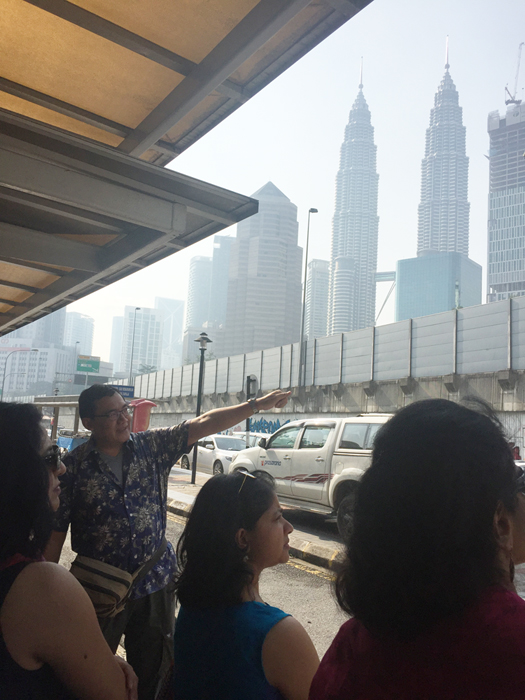 |
We met at Kampung Baru LRT station where Nadge immediately got to work by pointing out the three structures which form the great divide between traditional KB and modern Kuala Lumpur - namely the LRT, the river and the elevated highway.
He also told us that where we were standing was a swamp in 1898 with a few traditional Malay houses but all that was about to change...
In 1899, KL was being run by the British who had been invited in by the Sultan of Selangor. He had issued a treaty for the British to administer the city on his behalf. It was a rapidly growing city because of all the labourers coming in to work at the tin mines. Malay farmers were being pushed out and the British began to worry about the food supply.
KB was thus designated an area for farmers to grow food in peace. In 1900, 223 acres were set aside for the farmers. The KB area is unique in that it is the only part of KL which came about because of an official government law (Malay Agricultural Settlement), all the rest of KL has evolved organically.
Under Rule 4 of the Act, any Malay person could apply for a plot of land in KB, the major condition was that they had to grow food. People came from all over the peninsula and Sumatra, and the architecture of the original houses reflect this influx from the different regions. |
|
The population of KL was 20,000 in 1900, and it covered 232 sq kms. For your next quiz: KL is the second smallest city in SE Asia and also the youngest city. (Extra kudos for knowing that Brunei city Bandar Seri Begawan is the oldest, from the 6th Century, and smallest.) |
|
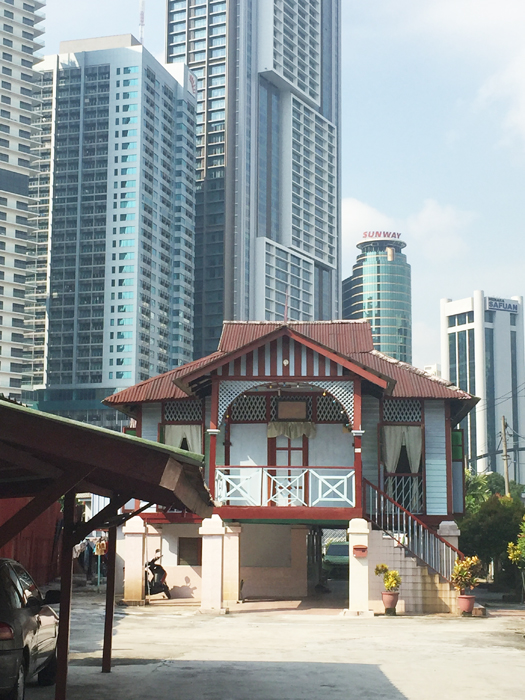 |
The same family has occupied this site since 1913, though the present house was built in 1949 to replace the original, smaller house. The family was from the north of Malaysia and various features represent this: the symmetrical design, the veranda at the front, staircase at the front (can be either to the left or the right for practical purposes). The house is also traditionally raised on stilts, this is for 6 reasons (Nadge helpfully made this bit into a quiz!):
1. Keep flood waters away from the house.
2. Keep wild life away from the house.
3. Better ventilation: a house raised off the ground can be typically 3 or 4 degrees cooler than one on the ground. However this benefit is cancelled out if a zinc roof replaces the traditional attap roof, as is the case here.
4. A deterrent against thieves.
5. Underneath the house is used as an extra living space for relaxing, working, etc. |
|
6. Underneath the house is used as storage - every house had a boat for when there was flooding, and the boat would be kept there, also the chicken coop and goat pen. Of course, nowadays, people are keeping cars under there, not boats. |
|
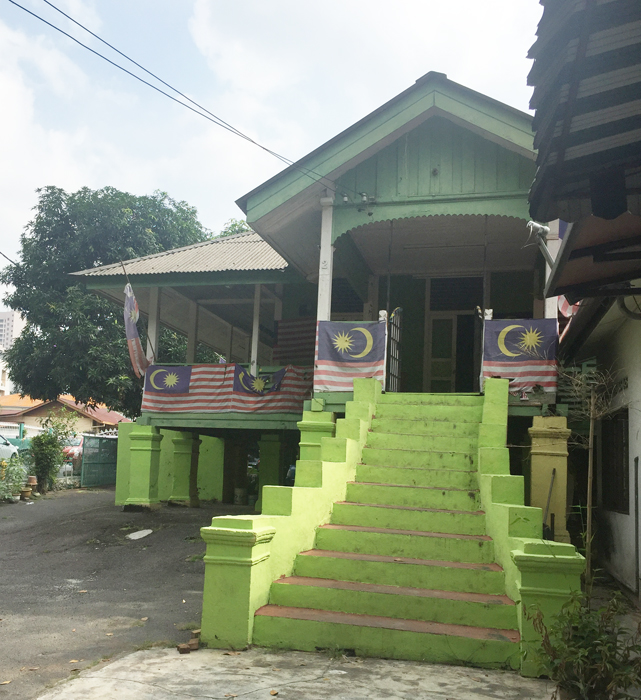 |
This is a stylised Perak house - the main addition is the outer veranda - which here is very big for the size of the plot of land - this shows that it was previously a much bigger plot and the owners were wealthy. Note the modern addition of concrete, not wooden, pillars.
By the 1930s the landowners were no longer required to do farming because of refrigeration and better schooling (which meant the children were better educated and were going into business rather than farming) so plots were divided up between family members. THIS IS AN IMPORTANT POINT WHICH NADGE REFFERRED TO LATER! |
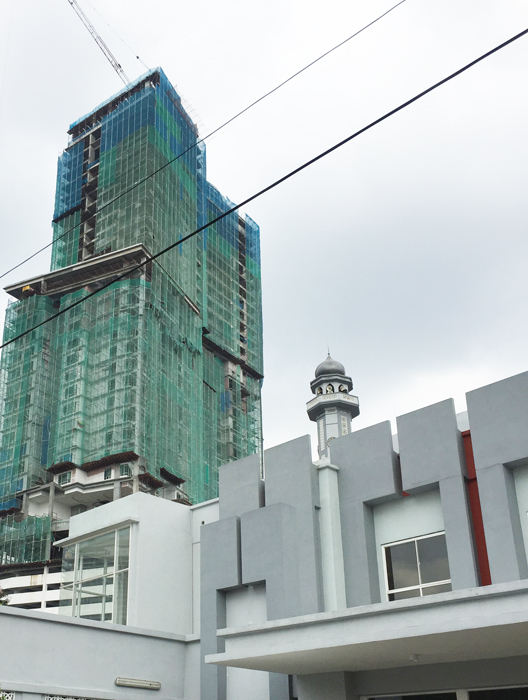 |
Mosque - this has changed so much in recent years as the original building has been almost entirely covered by a block-like extension. The original Masjid Jamek Kampong Bharu of 1895 was very small and served very few houses. By 1956 it was already too small so a collection was taken from each land owning family and the government matched what was raised and a new mosque was built. Masjid meaning 'mosque'. Jamek: Arab word meaning 'congregation'.
The traditional onion dome of the mosque is a feature of Moghul architecture brought to Malaysia by the British - this style was embraced by the Malays and became a traditional Islamic architectural style.
A unique feature of the Masjid Jamek Kampong Bharu is the making of Bubur lambuk every day throughout Ramadan. The name translates as 'churning porridge' and is made in the mosque from food donations, typically cooked for 6-8hrs and 3000 packets are handed out to visitors - (don't need to be poor or Muslim, tourists are welcome, but get there early as it goes fast!) each visitor is allowed up to 4 packets each for their families, no more than this as they don't want people to sell it. It is made to a secret recipe - only 7 people at any one time know the ingredients, when one dies, another person shares the recipe.
|
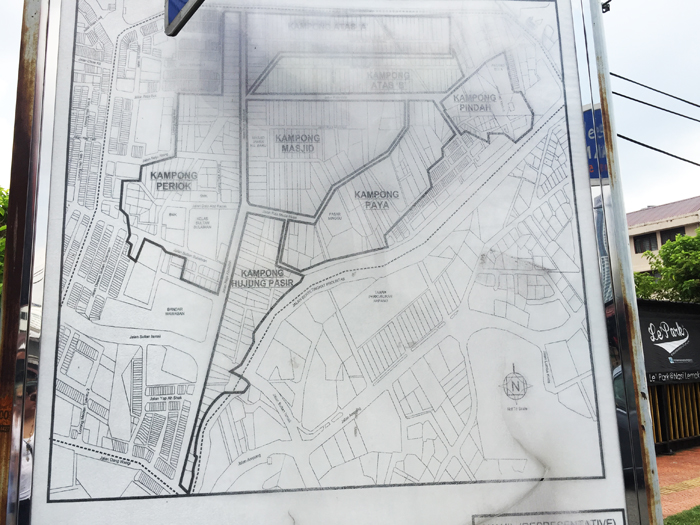 |
Map: this shows the 7 different administration districts within Kampung Baru: names are descriptive e.g. Kampung Paya - paya means swamp
Kampung Periok - periok means pots and pans |
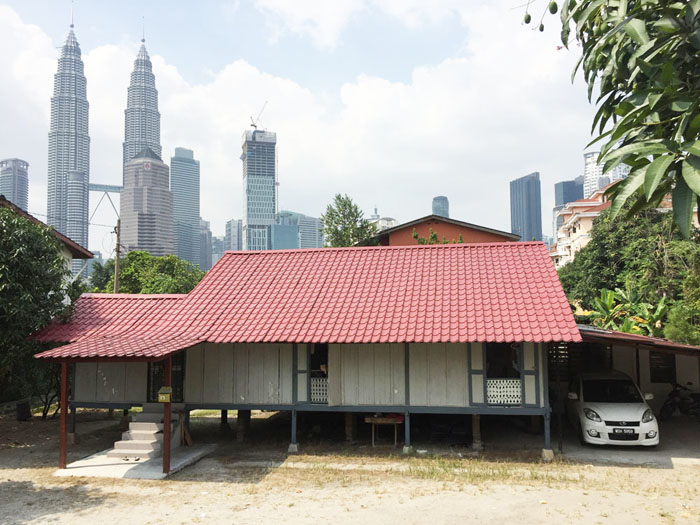 |
This is now the oldest house in KB, you can still see a lot of original features e.g. the wooden mortice and tenon joints of the framework shows it was built without nails. Also note - the pile of bricks underneath to support the sagging floor, DIY renovation! It also has a new zinc roof.
Nadge then spoke about what will happen to KB. The short answer is that no one knows - there is a strong movement of the residents within KB to sell off and make money, and it's seen as outsiders who want to keep the heritage site. However, surveys of the landowners seem to suggest a three way split in opinion: |
|
One third want to sell - this is a very vocal group!
One third want to keep the heritage
One third undecided.
Interestingly, as the residents are now 4th or 5th generation, and the land has been subdivided so many times in families (remember the subdividing of land?), one plot could have up to 200 co-owners. Contacting all of them and getting agreement with all of them can be an impossible task so even though they may want to sell, legally they may not be able to so KB may go forward into the future but only because of this legal nightmare.
At this point our tour of KB came to a close and happily we were at a very interesting local restaurant!
It was a great morning, very informative and I would thoroughly recommend Nadge as a guide. he is a mine of information - he told us far too much to put in an article: where the best steaks are found, why it used to be spelled Kampong Bharu, why padi didn't succeed but vegetables did, the list goes on and on.
Text and photos by Jeanie Kennedy |
|




